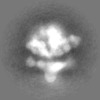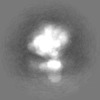[English] 日本語
 Yorodumi
Yorodumi- EMDB-0620: Full length HIV-1 Envelope glycoprotein clone AMC011 in complex w... -
+ Open data
Open data
- Basic information
Basic information
| Entry | Database: EMDB / ID: EMD-0620 | ||||||||||||
|---|---|---|---|---|---|---|---|---|---|---|---|---|---|
| Title | Full length HIV-1 Envelope glycoprotein clone AMC011 in complex with PGT151 Fab and PGZL1 Fab | ||||||||||||
 Map data Map data | AMC011 FL in complex with PGT151 and PGZL1 Fabs | ||||||||||||
 Sample Sample |
| ||||||||||||
| Biological species |  Homo sapiens (human) Homo sapiens (human) | ||||||||||||
| Method | single particle reconstruction / cryo EM / Resolution: 8.9 Å | ||||||||||||
 Authors Authors | Rantalainen KR | ||||||||||||
| Funding support |  United States, 3 items United States, 3 items
| ||||||||||||
 Citation Citation |  Journal: Nat Commun / Year: 2019 Journal: Nat Commun / Year: 2019Title: An MPER antibody neutralizes HIV-1 using germline features shared among donors. Authors: Lei Zhang / Adriana Irimia / Lingling He / Elise Landais / Kimmo Rantalainen / Daniel P Leaman / Thomas Vollbrecht / Armando Stano / Daniel I Sands / Arthur S Kim / / Pascal Poignard / ...Authors: Lei Zhang / Adriana Irimia / Lingling He / Elise Landais / Kimmo Rantalainen / Daniel P Leaman / Thomas Vollbrecht / Armando Stano / Daniel I Sands / Arthur S Kim / / Pascal Poignard / Dennis R Burton / Ben Murrell / Andrew B Ward / Jiang Zhu / Ian A Wilson / Michael B Zwick /    Abstract: The membrane-proximal external region (MPER) of HIV-1 envelope glycoprotein (Env) can be targeted by neutralizing antibodies of exceptional breadth. MPER antibodies usually have long, hydrophobic ...The membrane-proximal external region (MPER) of HIV-1 envelope glycoprotein (Env) can be targeted by neutralizing antibodies of exceptional breadth. MPER antibodies usually have long, hydrophobic CDRH3s, lack activity as inferred germline precursors, are often from the minor IgG3 subclass, and some are polyreactive, such as 4E10. Here we describe an MPER broadly neutralizing antibody from the major IgG1 subclass, PGZL1, which shares germline V/D-region genes with 4E10, has a shorter CDRH3, and is less polyreactive. A recombinant sublineage variant pan-neutralizes a 130-isolate panel at 1.4 μg/ml (IC). Notably, a germline revertant with mature CDR3s neutralizes 12% of viruses and still binds MPER after DJ reversion. Crystal structures of lipid-bound PGZL1 variants and cryo-EM reconstruction of an Env-PGZL1 complex reveal how these antibodies recognize MPER and viral membrane. Discovery of common genetic and structural elements among MPER antibodies from different patients suggests that such antibodies could be elicited using carefully designed immunogens. | ||||||||||||
| History |
|
- Structure visualization
Structure visualization
| Movie |
 Movie viewer Movie viewer |
|---|---|
| Structure viewer | EM map:  SurfView SurfView Molmil Molmil Jmol/JSmol Jmol/JSmol |
| Supplemental images |
- Downloads & links
Downloads & links
-EMDB archive
| Map data |  emd_0620.map.gz emd_0620.map.gz | 115 MB |  EMDB map data format EMDB map data format | |
|---|---|---|---|---|
| Header (meta data) |  emd-0620-v30.xml emd-0620-v30.xml emd-0620.xml emd-0620.xml | 13.8 KB 13.8 KB | Display Display |  EMDB header EMDB header |
| FSC (resolution estimation) |  emd_0620_fsc.xml emd_0620_fsc.xml | 11.4 KB | Display |  FSC data file FSC data file |
| Images |  emd_0620.png emd_0620.png | 119 KB | ||
| Masks |  emd_0620_msk_1.map emd_0620_msk_1.map | 125 MB |  Mask map Mask map | |
| Others |  emd_0620_half_map_1.map.gz emd_0620_half_map_1.map.gz emd_0620_half_map_2.map.gz emd_0620_half_map_2.map.gz | 98.4 MB 98.5 MB | ||
| Archive directory |  http://ftp.pdbj.org/pub/emdb/structures/EMD-0620 http://ftp.pdbj.org/pub/emdb/structures/EMD-0620 ftp://ftp.pdbj.org/pub/emdb/structures/EMD-0620 ftp://ftp.pdbj.org/pub/emdb/structures/EMD-0620 | HTTPS FTP |
-Validation report
| Summary document |  emd_0620_validation.pdf.gz emd_0620_validation.pdf.gz | 78.2 KB | Display |  EMDB validaton report EMDB validaton report |
|---|---|---|---|---|
| Full document |  emd_0620_full_validation.pdf.gz emd_0620_full_validation.pdf.gz | 77.3 KB | Display | |
| Data in XML |  emd_0620_validation.xml.gz emd_0620_validation.xml.gz | 493 B | Display | |
| Arichive directory |  https://ftp.pdbj.org/pub/emdb/validation_reports/EMD-0620 https://ftp.pdbj.org/pub/emdb/validation_reports/EMD-0620 ftp://ftp.pdbj.org/pub/emdb/validation_reports/EMD-0620 ftp://ftp.pdbj.org/pub/emdb/validation_reports/EMD-0620 | HTTPS FTP |
-Related structure data
| Related structure data |  6o3dC 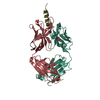 6o3gC  6o3jC 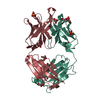 6o3kC 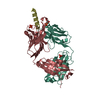 6o3lC  6o3uC 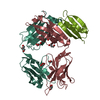 6o41C 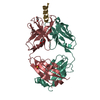 6o42C C: citing same article ( |
|---|---|
| Similar structure data |
- Links
Links
| EMDB pages |  EMDB (EBI/PDBe) / EMDB (EBI/PDBe) /  EMDataResource EMDataResource |
|---|
- Map
Map
| File |  Download / File: emd_0620.map.gz / Format: CCP4 / Size: 125 MB / Type: IMAGE STORED AS FLOATING POINT NUMBER (4 BYTES) Download / File: emd_0620.map.gz / Format: CCP4 / Size: 125 MB / Type: IMAGE STORED AS FLOATING POINT NUMBER (4 BYTES) | ||||||||||||||||||||||||||||||||||||||||||||||||||||||||||||
|---|---|---|---|---|---|---|---|---|---|---|---|---|---|---|---|---|---|---|---|---|---|---|---|---|---|---|---|---|---|---|---|---|---|---|---|---|---|---|---|---|---|---|---|---|---|---|---|---|---|---|---|---|---|---|---|---|---|---|---|---|---|
| Annotation | AMC011 FL in complex with PGT151 and PGZL1 Fabs | ||||||||||||||||||||||||||||||||||||||||||||||||||||||||||||
| Projections & slices | Image control
Images are generated by Spider. | ||||||||||||||||||||||||||||||||||||||||||||||||||||||||||||
| Voxel size | X=Y=Z: 1.03 Å | ||||||||||||||||||||||||||||||||||||||||||||||||||||||||||||
| Density |
| ||||||||||||||||||||||||||||||||||||||||||||||||||||||||||||
| Symmetry | Space group: 1 | ||||||||||||||||||||||||||||||||||||||||||||||||||||||||||||
| Details | EMDB XML:
CCP4 map header:
| ||||||||||||||||||||||||||||||||||||||||||||||||||||||||||||
-Supplemental data
-Mask #1
| File |  emd_0620_msk_1.map emd_0620_msk_1.map | ||||||||||||
|---|---|---|---|---|---|---|---|---|---|---|---|---|---|
| Projections & Slices |
| ||||||||||||
| Density Histograms |
-Half map: Half map 2- AMC011 FL in complex with PGT151 and PGZL1 Fabs
| File | emd_0620_half_map_1.map | ||||||||||||
|---|---|---|---|---|---|---|---|---|---|---|---|---|---|
| Annotation | Half map 2- AMC011 FL in complex with PGT151 and PGZL1 Fabs | ||||||||||||
| Projections & Slices |
| ||||||||||||
| Density Histograms |
-Half map: Half map 1- AMC011 FL in complex with PGT151 and PGZL1 Fabs
| File | emd_0620_half_map_2.map | ||||||||||||
|---|---|---|---|---|---|---|---|---|---|---|---|---|---|
| Annotation | Half map 1- AMC011 FL in complex with PGT151 and PGZL1 Fabs | ||||||||||||
| Projections & Slices |
| ||||||||||||
| Density Histograms |
- Sample components
Sample components
-Entire : HIV-1 Envelope glycoprotein in complex with human antibody Fab fr...
| Entire | Name: HIV-1 Envelope glycoprotein in complex with human antibody Fab fragments PGT151 and PGZL1 |
|---|---|
| Components |
|
-Supramolecule #1: HIV-1 Envelope glycoprotein in complex with human antibody Fab fr...
| Supramolecule | Name: HIV-1 Envelope glycoprotein in complex with human antibody Fab fragments PGT151 and PGZL1 type: complex / ID: 1 / Parent: 0 |
|---|---|
| Source (natural) | Organism:  Homo sapiens (human) / Strain: HEK293F Homo sapiens (human) / Strain: HEK293F |
| Recombinant expression | Organism:  Homo sapiens (human) / Recombinant strain: HEK293F Homo sapiens (human) / Recombinant strain: HEK293F |
-Experimental details
-Structure determination
| Method | cryo EM |
|---|---|
 Processing Processing | single particle reconstruction |
| Aggregation state | particle |
- Sample preparation
Sample preparation
| Concentration | 5.6 mg/mL |
|---|---|
| Buffer | pH: 7.4 |
| Grid | Details: unspecified |
| Vitrification | Cryogen name: ETHANE |
- Electron microscopy
Electron microscopy
| Microscope | FEI TITAN KRIOS |
|---|---|
| Image recording | Film or detector model: GATAN K2 SUMMIT (4k x 4k) / Detector mode: COUNTING / Average exposure time: 11.5 sec. / Average electron dose: 4.4 e/Å2 |
| Electron beam | Acceleration voltage: 300 kV / Electron source:  FIELD EMISSION GUN FIELD EMISSION GUN |
| Electron optics | C2 aperture diameter: 100.0 µm / Illumination mode: FLOOD BEAM / Imaging mode: BRIGHT FIELD / Cs: 2.7 mm |
| Experimental equipment |  Model: Titan Krios / Image courtesy: FEI Company |
 Movie
Movie Controller
Controller











 Z (Sec.)
Z (Sec.) Y (Row.)
Y (Row.) X (Col.)
X (Col.)






































